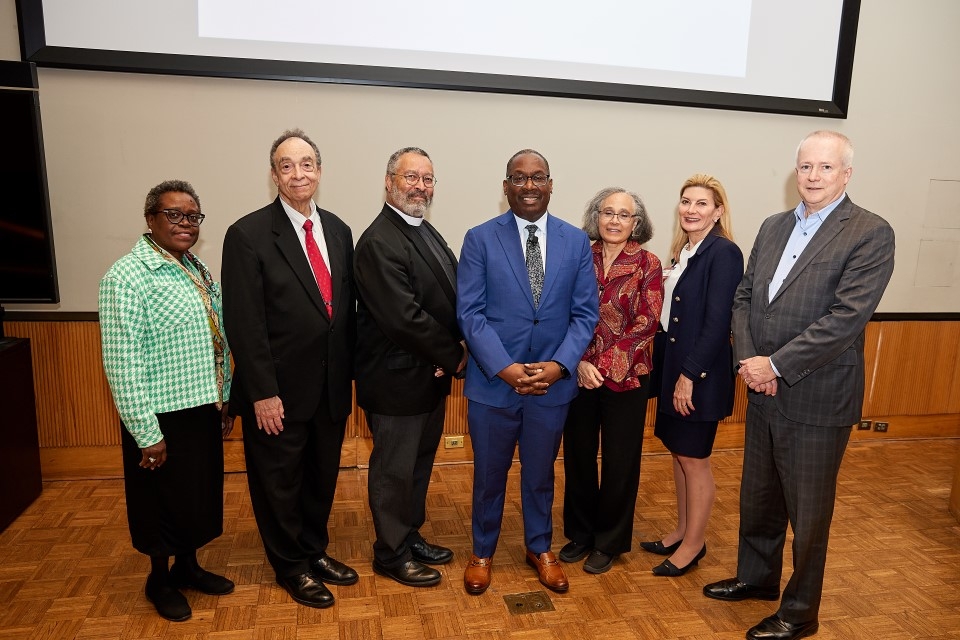To imagine a society without racial disparities in health care, we must consider the real reasons inequities exist, said Dr. Thomas LaVeist, Dean and Weatherhead Presidential Chair in Health Equity at the Tulane University School of Public Health and Tropical Medicine, in his keynote address on April 15 for Weill Cornell Medicine’s sixth annual Diversity Week.
Dr. LaVeist delivered the Elizabeth A. Wilson-Anstey, EdD Lecture, “My Journey to Discover Why African Americans Live Sicker and Die Younger,” as part of the annual celebration of Weill Cornell Medicine’s commitment to greater equity, diversity and inclusion in academic medicine and health care.
“The racial group you belong to, unfortunately, is a strong predictor of your mortality,” said Dr. LaVeist. “The rates have come down over the years, but the relative differences between populations have not changed. Why does this pattern persist? How do we intervene to stop this from happening?”

Dr. Thomas LaVeist. Credit: Travis Curry
Dr. LaVeist provided compelling evidence showing why the three most accepted reasons for disparities in health care are actually myths and part of the problem. First, he illustrated how fixing access to care in and of itself is insufficient to address racial inequalities using an example of patients at one hospital who should all have received referrals for cardiac interventions according to national health guidelines. All the patients were fully insured and had access to the same experts, yet the percentage of Black patients receiving referrals was much lower than for white patients.
Next, Dr. LaVeist addressed the myth that biological differences drive racial disparities in health care. He showed how census categories for race have expanded significantly and changed over time. “Racial categories we rely on in our research are determined by political and social processes,” he said. “It’s a political decision whether we collect race and ethnicity together. As a person of Dominican descent, my racial group, Black Hispanics, has now disappeared from data systems.”
Using the example of a heart failure drug approved specifically for Black patients, Dr. LaVeist reviewed the multicultural ancestry of famous Black individuals to demonstrate the futility of using skin color alone to identify those most likely to benefit. He also explained the faulty logic of comparing effectiveness rates between racial groups in drug studies. “If you’re part of the 75% of Black patients that benefitted, you benefitted. If you’re part of the 65% of white patients that benefitted, you benefitted—the Black patient didn’t benefit more than the white patient,” he explained.
Finally, Dr. LaVeist addressed the common belief that social and economic factors drive racial inequalities. He studied differences in the incidence of hypertension in two census tracts containing an equal percentage of Black and white individuals with similar income and education levels. He found a significantly smaller disparity in the odds of hypertension compared to large population studies by the United States Department of Health and Human Services. “Most medical schools teach their students that African Americans have twice the odds of being hypertensive compared with whites, and the most likely interpretation is that there is a biological or genetic factor,” Dr. LaVeist said.
“The communities people live in, and their exposures are the real drivers of disparities, not something endemic to the person.” For instance, living in disadvantaged neighborhoods with a greater number of liquor stores and fast-food restaurants will have an impact on lifestyle choices and ultimately health outcomes unrelated to genetics.
“We need to find better ways to account for risk profiles in different neighborhoods,” said Dr. LaVeist, who grew up in Brownsville, Brooklyn, a neighborhood with the highest concentration of housing projects in the United States. “Our assumptions about health equity may not be correct because the studies they are based on weren’t done in a sufficiently nuanced way to accurately compare individual people.”
“Ultimately, health, education, wealth and the criminal justice system are all interconnected and impact each other,” Dr. LaVeist concluded. “We’ll never resolve health disparities unless we collaborate with people working on the other areas beyond health care.”

